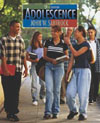John W. Santrock,
University of Texas, Dallas
| adolescents who are gifted | They are characterized by having above average intelligence (usually defined as an IQ of 120 or higher) and/or superior talent in some domain such as art, music, or mathematics.
|
 |
 |
 |
| aptitude-treatment interaction (ATI) | This interaction stresses the importance of both the attitudes and the characteristics of the adolescent, such as academic potential or personality traits, and the treatments or experiences, such as the educational techniques that the adolescent receives. Aptitude refers to such characteristics as the academic potential and personality characteristics on which students differ; treatment refers to educational techniques, such as structured versus flexible classrooms.
|
 |
 |
 |
| attention deficit/hyperactivity disorder (ADHD) | Is a disability in which children and adolescents show one or more of the following characteristics over a period of time: 1) inattention, 2) hyperactivity, and 3) impulsivity.
|
 |
 |
 |
| authoritarian strategy of classroom management | Is restrictive and punitive. The focus is mainly on keeping order in the classroom rather than on instruction and learning.
|
 |
 |
 |
| authoritative strategy of classroom management | Encourages students to be independent thinkers and doers but still involves effective monitoring. Authoritative teachers engage students in considerable verbal give-and-take and show a caring attitude toward them. However, they still declare limits when necessary.
|
 |
 |
 |
| back-to-basics movement | This philosophy stresses that the function of schools should be the rigorous training of intellectual skills through such subjects as English, mathematics, and science.
|
 |
 |
 |
| cognitive constructivist approaches | Emphasizes the adolescent's active, cognitive construction of knowledge and understanding; an example of this approach is Piaget's theory.
|
 |
 |
 |
| direct instruction approach | A teacher-centered approach that is characterized by teacher direction and control, mastery of academic skills, high expectations for students' progress, and maximum time spent on learning tasks.
|
 |
 |
 |
| inclusion | Educating a child or adolescent with special education needs full-time in a general school program.
|
 |
 |
 |
| Individuals with Disabilities Education Act (IDEA) | This spells out broad mandates for services to all children and adolescents with disabilities. These include evaluation and eligibility determination, appropriate education and the Individualized Education Program (IEP), and least restrictive environment.
|
 |
 |
 |
| jigsaw classroom | Students from different cultural backgrounds are placed in a cooperative group in which they have to construct different parts of a project to reach a common goal.
|
 |
 |
 |
| learning disability | Describes individuals who 1) are of normal intelligence or above, 2) have difficulties in a least one academic area and usually several, and 3) their difficulties cannot be attributed to any other diagnosed problem or disorder, such as mental retardation.
|
 |
 |
 |
| least restrictive environment | A setting that is as similar as possible to the one in which the children, or adolescents without a disability are educated; under the Individuals with Disabilities Education Act, the child or adolescent must be educated in this setting.
|
 |
 |
 |
| permissive strategy of classroom management | Offers students considerable autonomy but provides them with little support for developing learning skills or managing their behavior.
|
 |
 |
 |
| Public Law 94-142 | The Education for All Handicapped Children Act, which requires all students with disabilities to be given a free, appropriate education and provides the funding to help implement this education.
|
 |
 |
 |
| social constructivist approach | Focus on collaboration with others to produce knowledge and understanding; an example of this approach is Vygotsky's theory.
|
 |
 |
 |
| top-dog phenomenon | The circumstance of moving from the top position (in elementary school, the oldest, biggest, and most powerful students) to the lowest position (in middle or junior high school, the youngest, smallest, and least powerful).
|



 2003 McGraw-Hill Higher Education
2003 McGraw-Hill Higher Education

 2003 McGraw-Hill Higher Education
2003 McGraw-Hill Higher Education